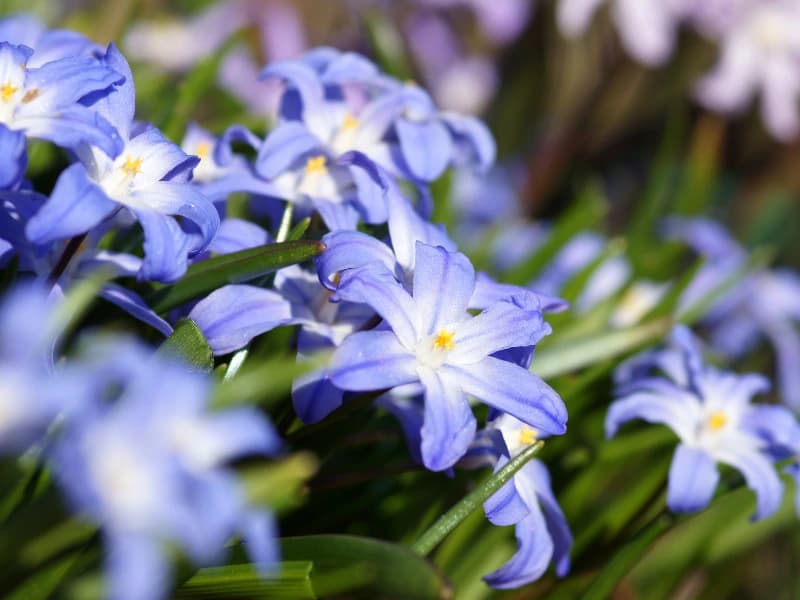- Written by Holly Hughes on August 9, 2022
Is there anything so glorious as the first burst of color in a wintry garden that announces the arrival of spring? That is exactly what you will get if you plant chionodoxa – an early spring bloomer that will cover your garden in starry blooms in wondrous shades of lavender, pink, blue, and white.
With such beautiful and bountiful flowers (chionodoxa strongly resembles creeping phlox in both its star-shaped petals and carpet-like appearance) is it any wonder chionodoxa is commonly referred to as Glory of the Snow?
So, if you are looking for a heavenly shrub that will bloom year-on-year with vigorous and heavenly splendor, look no further than chionodoxa: a gorgeous and eager early spring bloomer.
Of course, don’t forget you can always bring spring indoors at any time of year with a bouquet from SendFlowers – a flower delivery service with same day delivery, affordable prices, and a stunning selection!
What kind of plant is chionodoxa?
In case you haven’t yet discovered this low-maintenance plant, let’s get down to basics and ask, ‘what is chionodoxa?’
Chionodoxa is native to Eastern Europe and is an early spring perennial that naturalizes easily to return every year with a growing display of delicate, star-shaped flowers that are usually blue, pink, or white in color with a pale white center. Just like muscari (also known as grape hyacinth) and hyacinth, chionodoxa is a member of the Asparagaceae family.
There are lots of different chionodoxa varieties to choose from, from the Chionadoxa forbesii ‘Pink Giant’s’ rosy-colored blooms to the starry blue of Chionodoxa luciliae. This blue chionodoxa is one of the most popular varieties.

Chionodoxa is also generally pest- and disease-free, making them an easy and low-maintenance plant to keep in your garden.
Where can I grow chionodoxa?
These flowers are hardy in USDA zones 3-8. They grow best in partial to full sunlight and, given their joyous and colorful spread, make a great companion to deciduous trees which will shade chionodoxa foliage in the heat of summer yet give them the warm sunlight they need in spring.
What conditions does chionodoxa need to grow?
Chionodoxa thrives in partial to full sunlight and well-draining, rich soil with lots of organic material. These plants, like many others in your garden, are susceptible to root rot if over-watered so choosing an area with good drainage is crucial.
Having said this, chionodoxa need consistently moist soil to grow so regular watering as needed is also necessary for them to thrive.
To get the most from chionodoxa, you can add in grit or bark into your soil to improve drainage as well as compost or organic matter for a nutritional boost.
How deep should you plant chionodoxa bulbs?
Chionodoxa bulbs are usually best planted roughly 3” deep with the pointed part of the bulb facing upwards. Allow approximately 3” between each bulb also as this plant tends to spread over time.
When should you plant chionodoxa?
Given its early spring arrival, it’s best to plant chionodoxa in fall, allowing the bulbs plenty of time to settle and establish themselves before sprouting. Plant them in a place of partial to full sunlight with well-draining soil before the ground freezes and then wait to see their heavenly blooms in early springtime.
Chionodoxa does well almost anywhere once the soil and sun conditions are right. If you are short on garden space or have only a balcony or townhouse patio as your garden, you can even plant them in containers once you ensure there is enough drainage and the soil doesn’t dry out too much.
How to care for chionodoxas after blooming
If you’ve read any of our planting guides, you’ll already know exactly what to do to look after chionodoxa once it has finished blooming for the season. Let’s recap quickly though on how to keep these kinds of perennials happy and healthy after-flowering to ensure they come back bright and boisterous next spring.
Allow the foliage to die back. This is the most important thing you can do for chionodoxa: allowing its foliage to yellow and wither before you attempt to prune your plant. This is crucial because chionodoxa uses this time to store energy from its leaves that will help it endure winter and find the stamina to regrow next spring.
Once the foliage is well and truly wilted and yellowy brown, then you can cut it back (this will usually be in early summer) to within a couple of inches above the soil line.
This will allow it to rest over the winter and return in early spring with boisterous blooms sure to lift your heart and spirits. While chionodoxa is hardy in USDA zones 3-8, you can always cover the ground with an insulating layer of mulch to keep it warm over winter.
If you can’t wait that long for springtime blossoms, don’t forget that a subscription to seasonal flower delivery services like BloomsyBox or MonthlyClubs will give you a monthly bouquet of beautifully picked flowers to complement and epitomize every season!
Or, if you are working on your flower-arranging, you can even do it yourself with a subscription to EnjoyFlowers, which offers a special DIY bouquet of long-stemmed and exquisite blooms for you to trim and arrange in the comfort of your own home.
So, even if you don’t have an outdoor space or balcony to grow and enjoy your own chionodoxa blooms, you will never be short on ways to bring their blue, pink, and piercing white eye blooms into your home.